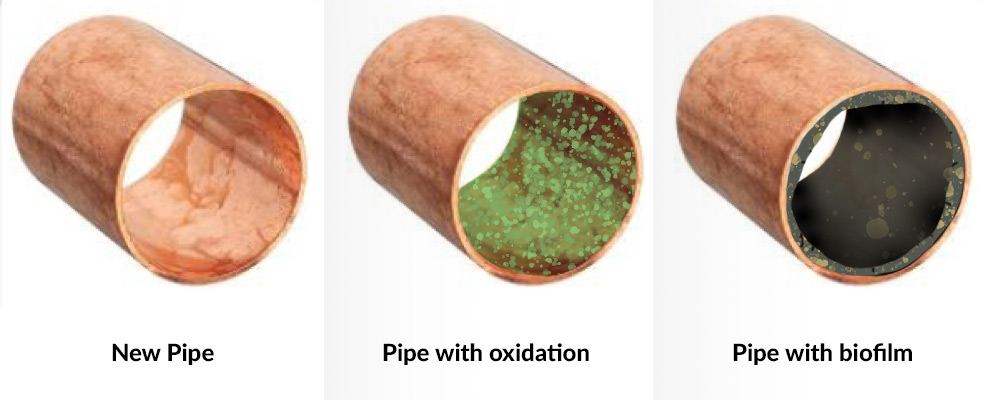Does Copper Piping Increase Biofilm and Legionella Due to Increased Surface Roughness?
The best facility plumbing designs will attempt to minimize the growth of biofilm. This may be done by reducing dead legs (sections of piping that rarely see flow), by ensuring proper water velocity, ensuring good recirculation, and by controlling temperature effectively. However, even the best copper piping systems are susceptible to biofilm growth because the copper piping surface roughens dramatically as the piping ages (see chart below). This is why waterborne pathogen and Legionella risk assessments and ongoing testing are important, even in the best plumbing systems.
 Biofilm formation in water systems is a factor for all piping, including copper pipes. It is influenced by several factors, and surface roughness is a significant one. Here is how it affects biofilm growth:
Biofilm formation in water systems is a factor for all piping, including copper pipes. It is influenced by several factors, and surface roughness is a significant one. Here is how it affects biofilm growth:
- Surface Texture: Rougher surfaces provide more surface area and have small, protected voids where Legionella and other pathogens can adhere more easily compared to smoother surfaces. These micro-environments protect the bacteria from shear forces of flowing water and even from some types of chemical cleaning.
- Adhesion and Colonization: Initial bacterial adhesion to the pipe surface is a critical step in biofilm formation, where over 90% of pathogens live. Rough surfaces facilitate this adhesion by providing more points of contact. Once bacteria adhere, they begin to colonize the area, forming a more complex biofilm structure.
- Protection Against Disinfectants: Biofilms in rougher surfaces are often more resistant to disinfectants. The irregularities in the surface can create zones that are less exposed to water flow and chemicals, providing a protective area for the biofilm to grow.
- Nutrient Accumulation: Rough surfaces can also trap organic materials and nutrients, which further support the growth of biofilm. These nutrients feed the bacteria, allowing the biofilm to thrive and expand.
In the context of copper piping, the surface roughness increases due to the oxidation of the copper. This increased surface roughness can contribute to increased corrosion and scaling. As corrosion and scaling become more pronounced, they lead to more significant biofilm development. This is a major concern in water supply systems because biofilms can degrade water quality, increase corrosion, and reduce the effectiveness of disinfectants, leading to a higher risk of opportunistic waterborne pathogens such as Legionella. Correct piping selection is critical in controlling biofilm. Copper piping for potable water may not be the best option to keep biofilm and Legionella under control. Regardless of piping selection, it is critical to have an up-to-date water management plan and regularly scheduled testing.
Just because a copper piping system was safe in the past does not mean it will be safe tomorrow. Contact the experts at Legionella Control Systems for recommendations that will protect the health and safety of your facility occupants while reducing your risk.







